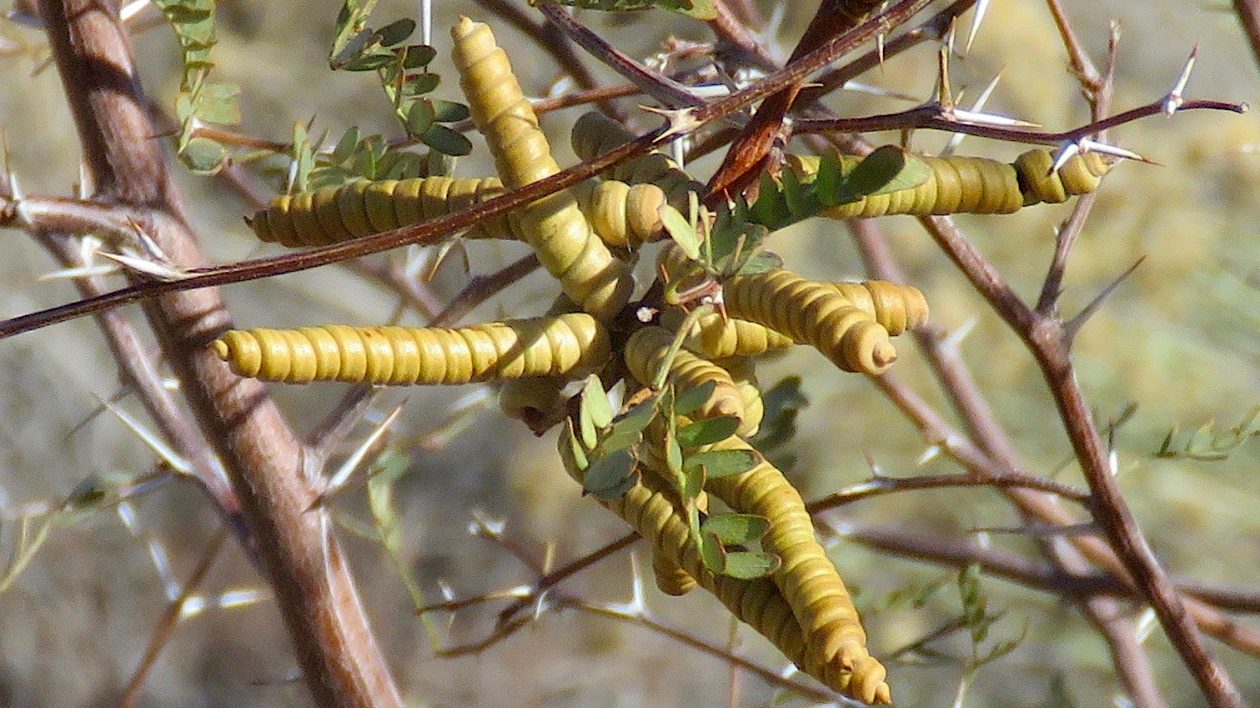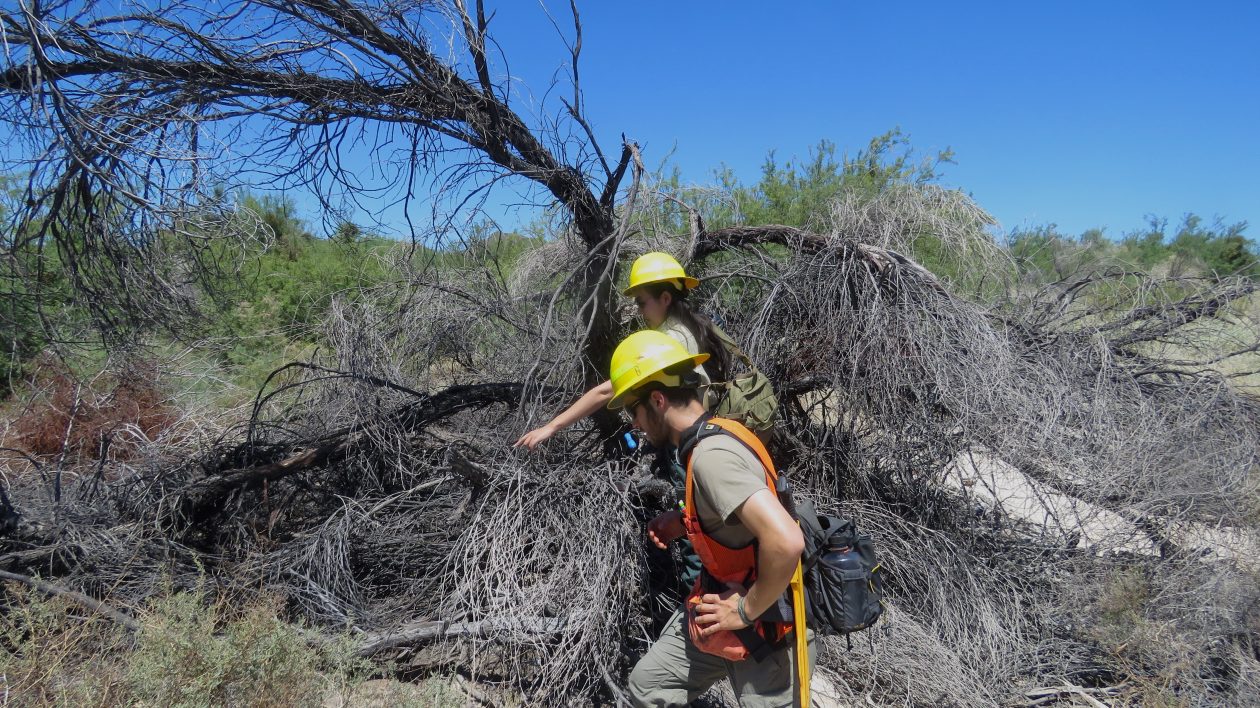At first, Leonard Warren noticed a dying tree here and there as he walked along the river’s edge. Their yellow leaves stood out, but he didn’t find it especially unusual. He was working as a field biologist at the time, studying desert songbirds, and he spent a lot of time in riparian areas. It soon became apparent that this was not an isolated case. The trees were dying throughout the valley. Rapidly.
Warren, now the Amargosa River project manager for The Nature Conservancy, became alarmed at this rapid die-off. The affected tree was screwbean mesquite (Prosopis pubescens), an ecologically important tree throughout the U.S. Southwest. The tree lined the Amargosa River, a waterway that flows above and below ground through southern Nevada and eastern California before sinking underground in Death Valley. In the desert environment, riparian areas like the Amargosa Valley provided critical habitat for migrating birds and many other species. The screwbean mesquite was a prominent component of that habitat.
Warren’s research into the topic revealed two disturbing facts. The first was that screwbean mesquites were dying across their range. The second was that almost no one knew the cause, and few were even looking into it.
In an era of disappearing species, the screwbean mesquite’s story was overlooked and untold.
“We are at risk of losing this species before we even understand what is going on,” says Warren.

The screwbean mesquite is found from southeastern California into southern Nevada, and parts of Utah, Arizona, New Mexico, western Texas and northern Mexico.
Several journal articles have reported on the disappearance of these trees, beginning with Bertin W. Anderson’s 2007 paper on the decline of screwbean mesquite in the Lower Colorado River Valley.
Andrerson wrote, “Unless there is sudden reversal of the trend that has been developing since at least 2005, screwbean appear to be headed for drastic reduction and, perhaps, extinction in the lower Colorado River Valley. Any drastic reduction in the numbers of screwbean mesquite without replacement would have a huge negative impact on wildlife, especially birds.”
There has not been a reversal. In fact, the dying trees have now been documented throughout the species’ range. A survey of the species, published the journal BioOne in 2014, found that screwbean mesquite had disappeared from more than one-third of the places it occurred a century ago. In many places, the disappearance had happened within the last 20 years. The survey also found that there was no place where screwbean mesquite was increasing in numbers.
Even areas identified in these reports as having healthy screwbean mesquite populations, like Nevada’s Ash Meadows National Wildlife Refuge, have since experienced significant loss of trees.
Despite the research, few conservationists are aware of the dying trees. And while there are theories and anecdotes, the reason behind the disappearing mesquites remains a mystery. Leonard Warren wants to change that.
“I will bend the ear of anyone who will listen,” he says. “I am sure some consider me a thorn in their side. I just want there to be research into what is going on with this decline. I want people to pay attention the issue.”

Food and Shelter in the Desert
Perhaps the most recognizable feature of a screwbean mesquite is its seedpod. The pod is gnarly and thick, protecting its nutrient rich seeds from wildlife. But a variety of animals still feast on the seeds, including birds, native rodents and even coyotes.
But the seeds are not the only way the screwbean mesquite provides for wildlife. The structure of the trees provides the ideal cover for many bird species, creating a desert oasis. Black-tailed gnatcatchers, loggerhead shrike, verdin, Bewick’s wren and many other species use the trees for cover year round. Endangered least Bell’s vireo use screwbean mesquite for nesting.
Each year, the flowering of the mesquite draws pollinating insects, which in turn provide food for insect-eating migratory birds. These birds time their migrations around this annual flowering. The migrants also use riparian areas as a resting spot after a difficult journey across the desert. A variety of warbler species, red-breasted and red-naped sapsuckers, northern flickers and others all rely on the habitat provided by screwbean mesquite.
“If the screwbean mesquite disappears, it will be a huge loss for migrating and desert riparian birds,” says Warren. “The tree is such a critical part of the ecosystem. We may not know the full ecological impact of its loss until 20, 40 or 100 years after it’s gone. But it will be a severe loss for riparian habitat in the desert Southwest.”

Speculation and the Need for Science
The research papers on screwbean mesquites have all offered possible causes for the disappearance. Many local conservationists and community members have also made observations that they believe identify the ecological culprit. But actual proof remains elusive.
“This has to be framed as a mystery,” says Warren. “Right now, so many of the ideas about the cause are speculative.”
For instance, near Warren’s residence in Shoshone, California, many community members noticed that screwbean mesquites started dying after tamarisk control. Tamarisks are an invasive plant species, notorious for their water use along desert rivers. Extensive control efforts have been aimed at removing the trees. In Shoshone, as in many areas, herbicides were used to remove the trees.

“After they used herbicide on the tamarisks, the screwbean mesquites started dying,” says Warren.
He noted that in nearby Beatty, Nevada – along the same river – the invasive control effort used mainly mechanical methods rather than herbicides. That area is one of the few locales where screwbean mesquites are not dying.
However, this is a good point to remind everyone that correlation does not necessarily mean causation. “Experts have pointed out that screwbean mesquites are dying in many places where there has been no tamarisk control,” says Warren. “Again, there is speculation but we need range-wide research.”
Research papers often identify drought and human changes to desert rivers – including both dams and loss of water flows – as potential causes.
The 2014 article in the journal BioOne by Steven A. Foldi asserts, “This is the first example of a declining species that is typically considered drought tolerant and is often found farther away from the stream course. Human alteration of rivers is therefore likely to be influencing plant communities as far away as a kilometer from the river itself.”
Climate change could be exacerbating the problem. Warren notes that night time temperatures in the desert are trending higher, and it is possible that screwbean mesquites need cooler nights to thrive.
The final suspect in this mystery is a potential pathogen. Around the world, invasive diseases and pests are wiping out native trees. Some have received a lot of press, like the Dutch elm disease and hemlock woolly adelgid wreaking havoc in eastern forests. Could something similar be happening with screwbean mesquite?

Recently, a tree pathologist and tree entomologist have begun taking tissue samples of screwbean mesquite, an important step in understanding the problem. One of their early findings was an unidentified fungus found on several afflicted trees. Whether this is a cause of the die-off, or an effect of whatever is afflicting the trees, remains to be seen. But the research may shed new light. Without efforts like this, the screwbean mesquite could disappear, having negative consequences for desert birds and river habitats.
“I wish this story had a happy ending,” says Warren. “But we actually don’t even know what the problem is. Hopefully there is someone out there who can help us make this a happy story. There is an opportunity for a researcher to make a difference. Until then, I’m going to be out there telling everyone I can about these disappearing trees.”




I hope they find out the mystery of the dying trees. For now I just planted a sapling in my yard. We all should thank you for the article it was very interesting.
I visited Texas in 1985 and locals were complaining then that the Mesquite trees were dying
I’ve noticed mesquite trees dying around the San Antonio Texas area and so i started searching and found this article. Has there been any update in causation for this issue?
I love in ARIVACA AZ and my mesquite trees are dying. I’ve noticed these vines that grow throughout the trees. It’s like their are being suffocated. Well I started removing the vines and the trees come back but with 6-8 inch thorns.
I just stumbled onto this article and was wondering: has there been more insight into the problem since this was published?
Thank you for raising awareness!
We are getting increased downwelling sky radiation which is infrared and is not reflected as easily as sunlight, so perhaps certain soil areas are heating more. So perhaps the soil temperatures are getting too high. Could try shade cloth to shade the soil around the trees.
Matthew,
Thank you very much for bringing this issue forward. The comments cover every aspect of life un the scientific and lay worlds.
Because this plant is dying widely in the Southwest US, this ussue should be studied throughout Tornillo’s range, including scientific and lay persons in Mexico.
Many species are dis appearing from the edges of species ranges. Is screwbean disappearing from the heart of its range?
Great article. I had no idea that the screwbean mesquites were endangered. I understand there are any number of elements that could connect to the causation behind the mesquite’s disappearance, but how much do you think the herbicides applied to the tamarisks plays a part in this – if at all? Your thoughts? The mystery here is fascinating and tragic.
Mike
https://www.bhmtreeservice.com
I have had several mature screw beans die. In cutting one tree down we found the banded ash borer present. They were most present in the cambium area but some were deeper into the tree. They were abundantly present in the mature state (fully developed) and in the larval state. This area has relatively little water table fluctuation (3 to 5 feet up and down) and no pestisides or herbicides have been used in the area. Whether the bores killed the tree or came after the tree died I don’t know. With the amount of bore damage done the trees could not have lived. The younger trees are doing fine. Could it be that the trees are dieing do to age?
I’ve read about this before (possibly here). Hope with more of a light on the issue, it will encourage more people to examine & research this – before it really is too late.
Please add “trees” to the tags as well so that tree enthusiasts don’t miss this wonderful article. I love trees, nature and environment and that’s why I choose tree transportation as a business so that they can be moved to another place but shouldn’t be cut.
Thanks!
Matt
https://www.smyrnagatreeexperts.com/